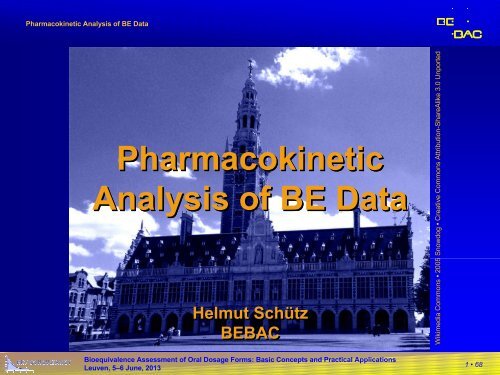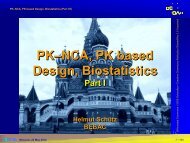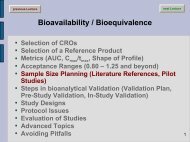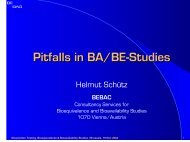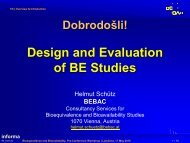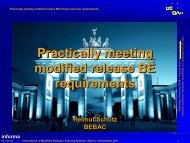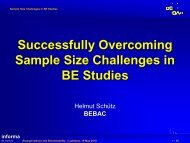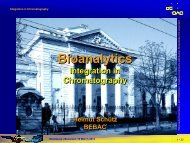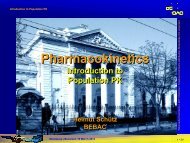Pharmacokinetic Analysis of BE Data - BEBAC ⢠Consultancy ...
Pharmacokinetic Analysis of BE Data - BEBAC ⢠Consultancy ...
Pharmacokinetic Analysis of BE Data - BEBAC ⢠Consultancy ...
You also want an ePaper? Increase the reach of your titles
YUMPU automatically turns print PDFs into web optimized ePapers that Google loves.
Wikimedia Commons • 2005 Snowdog • Creative Commons Attribution-ShareAlike3.0 Unported<strong>Pharmacokinetic</strong> <strong>Analysis</strong> <strong>of</strong> <strong>BE</strong> <strong>Data</strong>1• 68<strong>Pharmacokinetic</strong><strong>Analysis</strong> <strong>of</strong> <strong>BE</strong> <strong>Data</strong>Helmut Schütz<strong>BE</strong>BACBioequivalence Assessment <strong>of</strong> Oral Dosage Forms: Basic Concepts and Practical ApplicationsLeuven, 5–6 June, 2013
<strong>Pharmacokinetic</strong> <strong>Analysis</strong> <strong>of</strong> <strong>BE</strong> <strong>Data</strong>To bear in Remembrance...Whenever a theory appears to youas the only possible one, take this asa sign that you have neither under-stood the theory nor the problemwhich it was intended to solve.Even though it’s applied sciencewe’re dealin’ with, it still is – science!Karl R. PopperLeslie Z. BenetBioequivalence Assessment <strong>of</strong> Oral Dosage Forms: Basic Concepts and Practical ApplicationsLeuven, 5–6 June, 20132• 68
<strong>Pharmacokinetic</strong> <strong>Analysis</strong> <strong>of</strong> <strong>BE</strong> <strong>Data</strong>NCA vs. PK Modeling•<strong>Pharmacokinetic</strong> models•Useful for understanding the drug/formulation• Study design <strong>of</strong> BA/<strong>BE</strong>, e.g.,washout, accumulation / saturation to steady state•Drawbacks• Almost impossible to validate (fine-tuning <strong>of</strong> sideconditions, weighting schemes, s<strong>of</strong>tware, …)• Still a mixture <strong>of</strong> art and science• Impossible to recalculate any given dataset using differents<strong>of</strong>tware – sometimes even different versions <strong>of</strong> the sames<strong>of</strong>tware!• Not acceptable for evaluation <strong>of</strong> <strong>BE</strong> studies!Bioequivalence Assessment <strong>of</strong> Oral Dosage Forms: Basic Concepts and Practical ApplicationsLeuven, 5–6 June, 20133• 68
<strong>Pharmacokinetic</strong> <strong>Analysis</strong> <strong>of</strong> <strong>BE</strong> <strong>Data</strong>PK Modeling: AUC•Based on integration <strong>of</strong> a PK model;e.g., extravascular dose, one-compartment, nolag-timef ⋅ D kC t e eV k − ka() (k)eltkat= −AUC0−∞ael∞f ⋅ D k ⎛a1 1 ⎞ f ⋅D f ⋅D= ∫ C () t dt = ⎜ − ⎟= =V k0a−kel ⎝kel ka ⎠ V ⋅kelCLBioequivalence Assessment <strong>of</strong> Oral Dosage Forms: Basic Concepts and Practical ApplicationsLeuven, 5–6 June, 20134• 68
<strong>Pharmacokinetic</strong> <strong>Analysis</strong> <strong>of</strong> <strong>BE</strong> <strong>Data</strong>NCA: Single Dose•Noncompartmental methods do not rely on aPK (=compartmental) model•Also known as SHAM (Shape, Height, Area,Moments)•Metrics (plasma, single dose)• Extent <strong>of</strong> absorption (EU…), total exposure (US):AUC (Area Under the Curve)• Rate <strong>of</strong> absorption (EU…), peak exposure (US): C max• t max (EU…)• Early exposure (US, CAN): pAUC tmax ; AUC truncated atpopulation’s (CAN: subject’s) t max <strong>of</strong> the reference• Others: C min , Fluctuation, MRT, Occupancy time, t lag ,…Bioequivalence Assessment <strong>of</strong> Oral Dosage Forms: Basic Concepts and Practical ApplicationsLeuven, 5–6 June, 20135• 68
<strong>Pharmacokinetic</strong> <strong>Analysis</strong> <strong>of</strong> <strong>BE</strong> <strong>Data</strong>NCA: AUC•Since compartmental models not acceptablein <strong>BE</strong>, numeric approximation required•Linear trapezoidal rule¹•Lin-log trapezoidal rule¹ , ²•Lin-up/log-down trapezoidal rule•Cubic splines•Lagrange-polynomials•Simpson’s rule¹ Russian GL; only these two acceptable?² WHO GL; only acceptable method?Bioequivalence Assessment <strong>of</strong> Oral Dosage Forms: Basic Concepts and Practical ApplicationsLeuven, 5–6 June, 20136• 68
<strong>Pharmacokinetic</strong> <strong>Analysis</strong> <strong>of</strong> <strong>BE</strong> <strong>Data</strong>NCA: AUC•Linear trapezoidal rule•Linear interpolation between data points•Sections represented as trapezoids•Sides a, b = neighbouring concentrations•Time interval ha+b•Area <strong>of</strong> trapezoid A = h2•Totali= n− 1 i= n−1Ci+ Ci+11AUC0− ≈ ∑ tn+ 1−t ≈ ∑ C + C+ 1⋅ t+ 1−t2 2( ) ( ) ( )t i i i i i ii= 1 i=1Bioequivalence Assessment <strong>of</strong> Oral Dosage Forms: Basic Concepts and Practical ApplicationsLeuven, 5–6 June, 20137• 68
<strong>Pharmacokinetic</strong> <strong>Analysis</strong> <strong>of</strong> <strong>BE</strong> <strong>Data</strong>NCA: AUClinear trapezoidal rule0 2 4 6 8 10 121001008080concentration604060402020000 2 4 6 8 10 12time (h)Bioequivalence Assessment <strong>of</strong> Oral Dosage Forms: Basic Concepts and Practical ApplicationsLeuven, 5–6 June, 20138• 68
<strong>Pharmacokinetic</strong> <strong>Analysis</strong> <strong>of</strong> <strong>BE</strong> <strong>Data</strong>NCA: AUClinear trapezoidal rule:arithmetic means <strong>of</strong> concentrations0 2 4 6 8 10 121001008080concentration604060402020000 2 4 6 8 10 12time (h)Bioequivalence Assessment <strong>of</strong> Oral Dosage Forms: Basic Concepts and Practical ApplicationsLeuven, 5–6 June, 20139• 68
<strong>Pharmacokinetic</strong> <strong>Analysis</strong> <strong>of</strong> <strong>BE</strong> <strong>Data</strong>NCA: AUC•Log-linear trapezoidal rule•Assumes exponential elimination•Log-linear interpolation between data points•Only valid for iv administration; sections inabsorption phase underestimated if applied to ev•If C = 0 or subsequent concentrations are equal,section calculated by linear trapezoidal•Totali= n−1Ci+1− CiAUC0− t≈ ∑ ( t1 )ni+− tiCi=1 i+1lnCiBioequivalence Assessment <strong>of</strong> Oral Dosage Forms: Basic Concepts and Practical ApplicationsLeuven, 5–6 June, 201310 • 68
<strong>Pharmacokinetic</strong> <strong>Analysis</strong> <strong>of</strong> <strong>BE</strong> <strong>Data</strong>NCA: AUC•Lin-up/log-down trapezoidal rule•Hybrid <strong>of</strong> linear and log-linear•Sections with increasing or equal concentrations(C i+1 ≥ C i ) calculated by linear trapezoidal rule•Sections with decreasing concentrations(C i+1 < C i ) calculated by log-linear trapezoidal rule•Avoids bias in both absorption and distribution/elimination phases•Suitable for iv and ev•Suitable for multiphasic pr<strong>of</strong>ilesBioequivalence Assessment <strong>of</strong> Oral Dosage Forms: Basic Concepts and Practical ApplicationsLeuven, 5–6 June, 201311 • 68
<strong>Pharmacokinetic</strong> <strong>Analysis</strong> <strong>of</strong> <strong>BE</strong> <strong>Data</strong>NCA: AUClin-up/log-down trapezoidal rule0 2 4 6 8 10 121001008080concentration604060402020000 2 4 6 8 10 12time (h)Bioequivalence Assessment <strong>of</strong> Oral Dosage Forms: Basic Concepts and Practical ApplicationsLeuven, 5–6 June, 201312 • 68
<strong>Pharmacokinetic</strong> <strong>Analysis</strong> <strong>of</strong> <strong>BE</strong> <strong>Data</strong>NCA: AUClin-up/log-down trapezoidal rule:arithmetic ~geometric means <strong>of</strong> concentrations0 2 4 6 8 10 121001008080concentration604060402020000 2 4 6 8 10 12time (h)Bioequivalence Assessment <strong>of</strong> Oral Dosage Forms: Basic Concepts and Practical ApplicationsLeuven, 5–6 June, 201313 • 68
<strong>Pharmacokinetic</strong> <strong>Analysis</strong> <strong>of</strong> <strong>BE</strong> <strong>Data</strong>Example 1ModelAUC R 697.8AUC T 662.9T/R 95.00%linear trapezoidalT/R 94.85%concentration100806040AUCi (R) 707.6, AUCi (T) 670.9, T/R 94.8%, bias -0.20%0 4 8 12 16 20 24100ReferenceTest8060402020000 4 8 12 16 20 24time (h)Bioequivalence Assessment <strong>of</strong> Oral Dosage Forms: Basic Concepts and Practical ApplicationsLeuven, 5–6 June, 201314 • 68
<strong>Pharmacokinetic</strong> <strong>Analysis</strong> <strong>of</strong> <strong>BE</strong> <strong>Data</strong>Example 1ModelAUC R 697.8AUC T 662.9T/R 95.00%lin-up/log-downT/R 94.89%concentration100806040AUCi (R) 693.7, AUCi (T) 658.0, T/R 94.9%, bias -0.16%0 4 8 12 16 20 24100ReferenceTest8060402020000 4 8 12 16 20 24time (h)Bioequivalence Assessment <strong>of</strong> Oral Dosage Forms: Basic Concepts and Practical ApplicationsLeuven, 5–6 June, 201315 • 68
<strong>Pharmacokinetic</strong> <strong>Analysis</strong> <strong>of</strong> <strong>BE</strong> <strong>Data</strong>Example 2ModelAUC R 697.8AUC T 662.9T/R 95.00%linear trapezoidal12 h (R) missingT/R 92.53%concentration100806040AUCi (R) 725.1, AUCi (T) 670.9, T/R 92.5%, bias -2.60%0 4 8 12 16 20 24100ReferenceTest8060402020000 4 8 12 16 20 24time (h)Bioequivalence Assessment <strong>of</strong> Oral Dosage Forms: Basic Concepts and Practical ApplicationsLeuven, 5–6 June, 201316 • 68
<strong>Pharmacokinetic</strong> <strong>Analysis</strong> <strong>of</strong> <strong>BE</strong> <strong>Data</strong>Example 2ModelAUC R 697.8AUC T 662.9T/R 95.00%lin-up/log-down12 h (R) missingT/R 94.89%concentration100806040AUCi (R) 693.7, AUCi (T) 658.0, T/R 94.9%, bias -0.15%0 4 8 12 16 20 24100ReferenceTest8060402020000 4 8 12 16 20 24time (h)Bioequivalence Assessment <strong>of</strong> Oral Dosage Forms: Basic Concepts and Practical ApplicationsLeuven, 5–6 June, 201317 • 68
<strong>Pharmacokinetic</strong> <strong>Analysis</strong> <strong>of</strong> <strong>BE</strong> <strong>Data</strong>Spaghetti & other pastalinearlinear trapezoidal100Weired?Does thesemi-log plotreflect the calculation<strong>of</strong> AUC?concentration8060402000 4 8 12 16 20 24Overestimates AUCin the distribution/elimination phase…time (h)semilogarithmicsemilogarithmic1001005050concentration20105concentration2010522110 4 8 12 16 20 240 4 8 12 16 20 24time (h)Bioequivalence Assessment <strong>of</strong> Oral Dosage Forms: Basic Concepts and Practical ApplicationsLeuven, 5–6 June, 2013time (h)18 • 68
<strong>Pharmacokinetic</strong> <strong>Analysis</strong> <strong>of</strong> <strong>BE</strong> <strong>Data</strong>Spaghetti & other pastalinearlinearlin-up/log-down100100Does thelinear plotreflect the calculation<strong>of</strong> AUC?concentration8060402000 4 8 12 16 20 24concentration8060402000 4 8 12 16 20 24time (h)timesemilogarithmicconcentration1005020105Maybe we shouldchange the way wedraw spaghettiplots…210 4 8 12 16 20 24time (h)Bioequivalence Assessment <strong>of</strong> Oral Dosage Forms: Basic Concepts and Practical ApplicationsLeuven, 5–6 June, 201319 • 68
<strong>Pharmacokinetic</strong> <strong>Analysis</strong> <strong>of</strong> <strong>BE</strong> <strong>Data</strong>Recommendations•Don’t exclude a subject if only – a few – datapoints are missing (loss <strong>of</strong> power)•Only if linear rule is required for any reason:data imputation•Linear within increasing/equal values (C i+1 ≥ C i–1 )ˆ ti − ti−1Ci = Ci− 1+ ( Ci+ 1−Ci−1)ti+ 1−ti−1•Log-linear within decreasing values (C i+1 < C i–1 )Cˆi= et −tln C C C( )i i−1i−1+ln i− 1 i+1ti+ 1−ti−1Bioequivalence Assessment <strong>of</strong> Oral Dosage Forms: Basic Concepts and Practical ApplicationsLeuven, 5–6 June, 201320 • 68
<strong>Pharmacokinetic</strong> <strong>Analysis</strong> <strong>of</strong> <strong>BE</strong> <strong>Data</strong>Recommendations•Don’t exclude a subject … (cont’d)•Although I had never problems with this procedurein 500+ <strong>BE</strong> studies (stated in the protocol, accordingto SOP, and by validated s<strong>of</strong>tware) dataimputation may be unfamiliar to assessors•Lin-up/log-down trapezoidal not affected by missingvalues and unbiased estimates are obtainedBioequivalence Assessment <strong>of</strong> Oral Dosage Forms: Basic Concepts and Practical ApplicationsLeuven, 5–6 June, 201321 • 68
<strong>Pharmacokinetic</strong> <strong>Analysis</strong> <strong>of</strong> <strong>BE</strong> <strong>Data</strong>NCA: AUC Extrapolation•AUC 0–∞•Unweighted log-linear regression <strong>of</strong> ≥3 data pointsin the elimination phase•Extrapolation from AUC 0–t (regardless the method)CAUC = AUC + Cˆ∞ t or better AUCtˆt= AUC +∞λˆtλzzBioequivalence Assessment <strong>of</strong> Oral Dosage Forms: Basic Concepts and Practical ApplicationsLeuven, 5–6 June, 201322 • 68
<strong>Pharmacokinetic</strong> <strong>Analysis</strong> <strong>of</strong> <strong>BE</strong> <strong>Data</strong>NCA: AUC Extrapolation•Single dose only!•Method <strong>of</strong> estimation <strong>of</strong> λ z stated in protocol!• One-compartment model: ‘TTT’–method *(Two times t max to t z )• Maximum adjusted R² (Phoenix/WinNonlin, Kinetica)22 (1 − R ) ⋅( n−1)WinNonlin ≤5.3:Radj= 1−n − 2• Multi-compartment models: starting point = last inflection• Minimum AIC: AIC = n ⋅[ ln(2 ⋅ π ) + 1]+ n ⋅ ln( RSS n) + 2 ⋅ p• Visual inspection <strong>of</strong> fit mandatory!C max includedPhoenix/WNL ≥6.0: C max excluded* Scheerans C, Derendorf H, and C Kl<strong>of</strong>tProposal for a Standardised Identification <strong>of</strong> the Mono-Exponential Terminal Phase for OrallyAdministered DrugsBiopharm Drug Dispos 29, 145–57 (2008)Bioequivalence Assessment <strong>of</strong> Oral Dosage Forms: Basic Concepts and Practical ApplicationsLeuven, 5–6 June, 201323 • 68
<strong>Pharmacokinetic</strong> <strong>Analysis</strong> <strong>of</strong> <strong>BE</strong> <strong>Data</strong>NCA: AUC Extrapolation•AUC 0–∞•EMA (and all countires except US and Russia):No primary PK metric; but demonstrates that AUC 0–tis a reliable estimate <strong>of</strong> extent <strong>of</strong> absorption(i.e., extrapolated area ≤ 20% <strong>of</strong> AUC 0–∞ )• FDA: Primary PK metric (additionally to AUC 0–t )• What if extrapolated AUC 0–t > 20% <strong>of</strong> AUC 0–∞ in somesubjects?• EMA: Subjects should not be excluded, but requiresdiscussion if observed in > 20% <strong>of</strong> cases• Russia: Use AUC 0–∞ instead <strong>of</strong> AUC 0–t as primarymetric <strong>of</strong> the studyBioequivalence Assessment <strong>of</strong> Oral Dosage Forms: Basic Concepts and Practical ApplicationsLeuven, 5–6 June, 201324 • 68
<strong>Pharmacokinetic</strong> <strong>Analysis</strong> <strong>of</strong> <strong>BE</strong> <strong>Data</strong>NCA: AUC Extrapolation100plasma pr<strong>of</strong>ile (linear scale)80concentration60402000 4 8 12 16 20 24timeBioequivalence Assessment <strong>of</strong> Oral Dosage Forms: Basic Concepts and Practical ApplicationsLeuven, 5–6 June, 201325 • 68
<strong>Pharmacokinetic</strong> <strong>Analysis</strong> <strong>of</strong> <strong>BE</strong> <strong>Data</strong>NCA: AUC Extrapolation100plasma pr<strong>of</strong>ile (semilogarithmic scale)concentration10C tCˆt10 4 8 12 16 20 24timeBioequivalence Assessment <strong>of</strong> Oral Dosage Forms: Basic Concepts and Practical ApplicationsLeuven, 5–6 June, 201326 • 68
<strong>Pharmacokinetic</strong> <strong>Analysis</strong> <strong>of</strong> <strong>BE</strong> <strong>Data</strong>NCA: otheroPK Metrics•Single dose•C max and t max directly from pr<strong>of</strong>ile•Metrics describing the shape <strong>of</strong> the pr<strong>of</strong>ile• Early exposure (US, CAN): AUC tmax = pAUC truncated atpopulation (CAN: subject’s) t max <strong>of</strong> the reference• Biphasic MR formulations: pAUCs truncated at a prespecifiedcut-<strong>of</strong>f time point• FDA: Product specific guidances (methylphenidate,zolpidem)• EMA: All productsQuestions & Answers: positions on specific questions addressed to the pharmacokineticsworking partyEMA/618604/2008 Rev. 4 (16 February 2012)http://www.ema.europa.eu/docs/en_GB/document_library/Scientific_guideline/2009/09/WC500002963.pdfBioequivalence Assessment <strong>of</strong> Oral Dosage Forms: Basic Concepts and Practical ApplicationsLeuven, 5–6 June, 201327 • 68
<strong>Pharmacokinetic</strong> <strong>Analysis</strong> <strong>of</strong> <strong>BE</strong> <strong>Data</strong>NCA: otheroPK Metrics•Single dose•Metrics describing the shape <strong>of</strong> the pr<strong>of</strong>ile• C max /AUC• t 75% (Plateau time: interval where C(t) ≥ 75% <strong>of</strong> C max )*• HVD (Half value duration: time interval where C(t) ≥ 50%<strong>of</strong> C max )• Occupancy time, t ≥ MIC (time interval where C(t) is abovesome limiting concentration)* Russia: mandatory for sustained release formulationsBioequivalence Assessment <strong>of</strong> Oral Dosage Forms: Basic Concepts and Practical ApplicationsLeuven, 5–6 June, 201328 • 68
<strong>Pharmacokinetic</strong> <strong>Analysis</strong> <strong>of</strong> <strong>BE</strong> <strong>Data</strong>NCA: Urine•Noncompartmental methods (cont’d)•Extent <strong>of</strong> absorption (EU…), total exposure (US):Ae t (cumulative amount excreted); rarelyextrapolated to t = ∞•Rate <strong>of</strong> absorption, peak exposure (US):∆Ae max , t∆Ae max•EMA: C max , t max from plasma!Bioequivalence Assessment <strong>of</strong> Oral Dosage Forms: Basic Concepts and Practical ApplicationsLeuven, 5–6 June, 201329 • 68
<strong>Pharmacokinetic</strong> <strong>Analysis</strong> <strong>of</strong> <strong>BE</strong> <strong>Data</strong>NCA (Methods)•Multiple dose•Calculation <strong>of</strong> AUC τ (dosage interval τ );AUC ss,24h if more than o.a.d. and chronopharmacologicalvariation)•No extrapolation!•C ss,max and C ss,min directly from pr<strong>of</strong>ile•Peak-Trough-Fluctuation: (C ss,max –C ss,min )/C ss,av ,where C ss,av = AUC τ /τ•Swing: (C ss,max –C ss,min )/C ss,minBioequivalence Assessment <strong>of</strong> Oral Dosage Forms: Basic Concepts and Practical ApplicationsLeuven, 5–6 June, 201330 • 68
<strong>Pharmacokinetic</strong> <strong>Analysis</strong> <strong>of</strong> <strong>BE</strong> <strong>Data</strong>•Multiple doseNCA (Methods)•Assessment whether steady state is reached (ina linear PK system: AUC τ = AUC ∞ )• No recommendations in GLs (except EU/US Veterinary)• Not required according to comments to EMA’s <strong>BE</strong>-GL• MANOVA-model (sometimes in CAN, rarely used)• t-test <strong>of</strong> last two pre-dose concentrations• Hotelling’s T²• Linear regression <strong>of</strong> last three pre-dose concentrations,individually for each subject/treatment• Only the last method allows the exclusion <strong>of</strong> subjects beingnot in stead state. Other methods give only a yes|no result!Bioequivalence Assessment <strong>of</strong> Oral Dosage Forms: Basic Concepts and Practical ApplicationsLeuven, 5–6 June, 201331 • 68
<strong>Pharmacokinetic</strong> <strong>Analysis</strong> <strong>of</strong> <strong>BE</strong> <strong>Data</strong>NCA (Methods)200plasma pr<strong>of</strong>ile (linear scale)concentration1501005000 24 48 72 96 120 144timeC avslope: +0.0459395% CI: [-0.35266 | +0.44452]steady state demonstratedBioequivalence Assessment <strong>of</strong> Oral Dosage Forms: Basic Concepts and Practical ApplicationsLeuven, 5–6 June, 201332 • 68
<strong>Pharmacokinetic</strong> <strong>Analysis</strong> <strong>of</strong> <strong>BE</strong> <strong>Data</strong>NCA (Problems)•C min•Defined by EMA as the concentration (C trough )at the end <strong>of</strong> the dosing interval τ•Not implemented in PK s<strong>of</strong>tware: C min globalminimum concentration. Requires adaption.•More variable than C max (if little accumulation closeto LLOQ)•EMA requires pre-dose sampling at ≤–5 min andsampling at τ ±10 min•Common in o.a.d. MD studies last sampleat 23:55 in period 1 and at 24:00 in period 2…Bioequivalence Assessment <strong>of</strong> Oral Dosage Forms: Basic Concepts and Practical ApplicationsLeuven, 5–6 June, 201333 • 68
<strong>Pharmacokinetic</strong> <strong>Analysis</strong> <strong>of</strong> <strong>BE</strong> <strong>Data</strong>NCA (Problems)•Missing last samples may lead to ‘Apples-and-Oranges’ statistics (biased treatment effect)•If a reliable estimate <strong>of</strong> λ z is possible (≥3 datapoints), we can use an estimate• ± shift <strong>of</strong> C z according to λ z *ˆˆ z( z)= C e −λτ−t(1)Css,minz• or independent from measured C z( Cˆ0− ˆ λz⋅ ( t0+τ))Cˆ = e (2)ss,min* Gabrielsson J and D Weiner<strong>Pharmacokinetic</strong> & Pharmacodynamic <strong>Data</strong> <strong>Analysis</strong>: Concepts and ApplicationsSwedish Pharmaceutical Press, Stockholm, p163 (4 th ed. 2006)Bioequivalence Assessment <strong>of</strong> Oral Dosage Forms: Basic Concepts and Practical ApplicationsLeuven, 5–6 June, 201334 • 68
<strong>Pharmacokinetic</strong> <strong>Analysis</strong> <strong>of</strong> <strong>BE</strong> <strong>Data</strong>NCA (Problems)•Missing values I•Procedure for imputation must be stated in theprotocol; recommended:• in the absorption phase (t < t max ) by linear Interpolation <strong>of</strong>adjacent values• in the distribution/elimination phase (t ≥ t max ) by log/linearInterpolation <strong>of</strong> adjacent values• imputed value must not be used in estimating λ z !•Don’t rely on s<strong>of</strong>twares’ defaults!• Phoenix/WinNonlin interpolates linear – unless thelin-up/log-down trapezoidal method is used• Kinetica interpolates lin/log within descending valuesBioequivalence Assessment <strong>of</strong> Oral Dosage Forms: Basic Concepts and Practical ApplicationsLeuven, 5–6 June, 201335 • 68
<strong>Pharmacokinetic</strong> <strong>Analysis</strong> <strong>of</strong> <strong>BE</strong> <strong>Data</strong>NCA (Problems)10080ReferenceTestLLOQ = 10concentration60402000 12 24 36 48 60 72timeBioequivalence Assessment <strong>of</strong> Oral Dosage Forms: Basic Concepts and Practical ApplicationsLeuven, 5–6 June, 201336 • 68
<strong>Pharmacokinetic</strong> <strong>Analysis</strong> <strong>of</strong> <strong>BE</strong> <strong>Data</strong>NCA (Problems)•Missing values II•Last value <strong>of</strong> T missing(e.g., vial broken)• AUC tlast (48) T = 2407AUC tlast (72) R = 2984T/R = 80.67% biased!• Using AUC to t where C≥LLOQfor both formulations (48)AUC 48 T = 2534AUC 48 R = 2407T/R = 95% ‣ Not available in s<strong>of</strong>tware‣ Regulatory acceptance?time00.250.500.751.001.523469121624364872Referenceconc AUC 0-tBLQ 028.57 448.57 1362.50 2772.15 4483.26 8388.14 12690.14 21588.70 30484.07 47777.11 71970.71 94063.00 120850.00 166035.36 217225.00 253412.50 2984Bioequivalence Assessment <strong>of</strong> Oral Dosage Forms: Basic Concepts and Practical ApplicationsLeuven, 5–6 June, 2013concBLQTestAUC 0-t027.14 346.14 1359.38 2668.55 4279.10 7983.73 11985.63 20484.26 28979.86 45373.25 68367.18 89359.85 114747.50 157733.59 206323.75 2407Missing NA37 • 68
<strong>Pharmacokinetic</strong> <strong>Analysis</strong> <strong>of</strong> <strong>BE</strong> <strong>Data</strong>NCA (Problems)10080ReferenceTestLLOQ = 10concentration6040C 72 set to 02000 12 24 36 48 60 72timeBioequivalence Assessment <strong>of</strong> Oral Dosage Forms: Basic Concepts and Practical ApplicationsLeuven, 5–6 June, 201338 • 68
<strong>Pharmacokinetic</strong> <strong>Analysis</strong> <strong>of</strong> <strong>BE</strong> <strong>Data</strong>•Missing values IINCA (Problems)•Last value <strong>of</strong> T missing(e.g., vial broken)• Setting the first concentrationin the pr<strong>of</strong>ile where C
<strong>Pharmacokinetic</strong> <strong>Analysis</strong> <strong>of</strong> <strong>BE</strong> <strong>Data</strong>NCA (Problems)10080ReferenceTestLLOQ = 10concentration6040C 72 estimated from C 24 –C 482000 12 24 36 48 60 72timeBioequivalence Assessment <strong>of</strong> Oral Dosage Forms: Basic Concepts and Practical ApplicationsLeuven, 5–6 June, 201340 • 68
<strong>Pharmacokinetic</strong> <strong>Analysis</strong> <strong>of</strong> <strong>BE</strong> <strong>Data</strong>NCA (Problems)•Missing values II•Last value <strong>of</strong> T missing(e.g., vial broken)• Estimating the missing valuefrom elimination phase.AUC 72* T = 2835AUC 72 R = 2984T/R = 95% ‣ Not available in s<strong>of</strong>tware‣ Regulatory acceptance ±time00.250.500.751.001.523469121624364872ReferenceconcBLQAUC 0-t028.57 448.57 1362.50 2772.15 4483.26 8388.14 12690.14 21588.70 30484.07 47777.11 71970.71 94063.00 120850.00 166035.36 217225.00 253412.50 2984concBLQTestAUC 0-t027.14 346.14 1359.38 2668.55 4279.10 7983.73 11985.63 20484.26 28979.86 45373.25 68367.18 89359.85 114747.50 157733.59 206323.75 2407*11.88 *2835Bioequivalence Assessment <strong>of</strong> Oral Dosage Forms: Basic Concepts and Practical ApplicationsLeuven, 5–6 June, 201341 • 68
<strong>Pharmacokinetic</strong> <strong>Analysis</strong> <strong>of</strong> <strong>BE</strong> <strong>Data</strong>NCA (Problems)•Missing values II•Values below the lowerlimit <strong>of</strong> quantitation (LLOQ)• Example as before,but LLOQ = 12.5 (instead 10)AUC 72 : T = ?, R = 2984T/R = ?AUC 48 : T = 2407, R = 2534T/R = 95% AUC all : T = 2692, R = 2984T/R = 90.22% biased!AUC 72* : T = ?, R = 2984T/R = ?time24364872time24364872time24364872Referenceconc50.00AUC 0-t166035.36 217225.00 253412.50 2984Referenceconc50.00AUC 0-t166035.36 217225.00 253412.50 2984Referenceconc50.00AUC 0-t166035.36 217225.00 253412.50 2984conc47.50TestAUC 0-t157733.59 206323.75 2407BLQ NATestconc47.50AUC 0-t157733.59 206323.75 2407= *0 2692Testconc47.50AUC 0-t157733.59 206323.75 2407*11.88 NABioequivalence Assessment <strong>of</strong> Oral Dosage Forms: Basic Concepts and Practical ApplicationsLeuven, 5–6 June, 201342 • 68
<strong>Pharmacokinetic</strong> <strong>Analysis</strong> <strong>of</strong> <strong>BE</strong> <strong>Data</strong>NCA (Problems)What would you do?10080ReferenceTestLLOQ = 12.510080ReferenceTestLLOQ = 12.5concentration6040concentration6040200BQL0 12 24 36 48 60 72timeconcentration10020800604020ReferenceTestLLOQ = 12.50 12 24 36 48 60 72time00 12 24 36 48 60 72timeBioequivalence Assessment <strong>of</strong> Oral Dosage Forms: Basic Concepts and Practical ApplicationsLeuven, 5–6 June, 201343 • 68
<strong>Pharmacokinetic</strong> <strong>Analysis</strong> <strong>of</strong> <strong>BE</strong> <strong>Data</strong>Sampling at Cmax•With any [sic] given sampling scheme the‘true’ C max is missed•It is extremely unlikely that we sample exactly at thetrue C max for any given subject•High inter- and/or intra-subject variability(single point metric)•Variability higher than AUC’s•In many studies the win/loose metric!•Try to decrease variability• Increase sample size (more subjects)• Increase sampling within each subject (maybe better)Bioequivalence Assessment <strong>of</strong> Oral Dosage Forms: Basic Concepts and Practical ApplicationsLeuven, 5–6 June, 201344 • 68
<strong>Pharmacokinetic</strong> <strong>Analysis</strong> <strong>of</strong> <strong>BE</strong> <strong>Data</strong>Sampling at Cmax•Theoretical values (from PK simulation)C max : 41.9/53.5 (81.2%), t max : 6.11/4.02 (∆ 2.09)•# samples [2–12h]• n = 4‣ C max 78.3%‣ t max ∆ 4• n = 5‣ C max 78.3%‣ t max ∆ 4• n = 6‣ C max 79.8%‣ t max ∆ 1• n = 7‣ C max 81.2%‣ t max ∆ 255453525R theoreticalT theoreticalR sampledT sampled0 3 6 9 12Bioequivalence Assessment <strong>of</strong> Oral Dosage Forms: Basic Concepts and Practical ApplicationsLeuven, 5–6 June, 201345 • 68
<strong>Pharmacokinetic</strong> <strong>Analysis</strong> <strong>of</strong> <strong>BE</strong> <strong>Data</strong>Sampling at Cmax•Quote from the literature:C max was observed within two to five hoursafter oral administration…•Elimination is drug specific,•but what about absorption?•Formulation specific!•Dependent on the sampling schedule (in a strictsense study-specific)Bioequivalence Assessment <strong>of</strong> Oral Dosage Forms: Basic Concepts and Practical ApplicationsLeuven, 5–6 June, 201346 • 68
<strong>Pharmacokinetic</strong> <strong>Analysis</strong> <strong>of</strong> <strong>BE</strong> <strong>Data</strong>Sampling at Cmax50402–5 hrsarithmetic meangeometric meanmedian30k a = [0.182 | 0.260]201000 4 8 12 16 20 24Bioequivalence Assessment <strong>of</strong> Oral Dosage Forms: Basic Concepts and Practical ApplicationsLeuven, 5–6 June, 201347 • 68
<strong>Pharmacokinetic</strong> <strong>Analysis</strong> <strong>of</strong> <strong>BE</strong> <strong>Data</strong>Sampling at Cmax50402–5 hrsarithmetic meangeometric meanmedian30k a = 0.182t lag = [0 | 2.5]201000 4 8 12 16 20 24Bioequivalence Assessment <strong>of</strong> Oral Dosage Forms: Basic Concepts and Practical ApplicationsLeuven, 5–6 June, 201348 • 68
<strong>Pharmacokinetic</strong> <strong>Analysis</strong> <strong>of</strong> <strong>BE</strong> <strong>Data</strong>Another Problem•EMA GL on <strong>BE</strong> (2010)•Section 4.1.8 Reasons for exclusion 1)• A subject with lack <strong>of</strong> any measurable concentrations oronly very low plasma concentrations for referencemedicinal product. A subject is considered to have verylow plasma concentrations if its AUC is less than 5% <strong>of</strong>reference medicinal product geometric mean AUC (whichshould be calculated without inclusion <strong>of</strong> data from theoutlying subject). The exclusion <strong>of</strong> data […] will only beaccepted in exceptional cases and may question thevalidity <strong>of</strong> the trial.Remark: Only possible after unblinding!Bioequivalence Assessment <strong>of</strong> Oral Dosage Forms: Basic Concepts and Practical ApplicationsLeuven, 5–6 June, 201349 • 68
<strong>Pharmacokinetic</strong> <strong>Analysis</strong> <strong>of</strong> <strong>BE</strong> <strong>Data</strong>Another Problem•EMA GL on <strong>BE</strong> (2010)•Section 4.1.8 Resons for exclusion 1) cont’d• The above can, for immediate release formulations, be theresult <strong>of</strong> subject non-compliance […] and should as far aspossible be avoided by mouth check <strong>of</strong> subjects afterintake <strong>of</strong> study medication to ensure the subjects haveswallowed the study medication […]. The samples fromsubjects excluded from the statistical analysis should stillbe assayed and the results listed.Bioequivalence Assessment <strong>of</strong> Oral Dosage Forms: Basic Concepts and Practical ApplicationsLeuven, 5–6 June, 201350 • 68
<strong>Pharmacokinetic</strong> <strong>Analysis</strong> <strong>of</strong> <strong>BE</strong> <strong>Data</strong>Another Problem•Gastro-resistant (enteric coated) preparations•Gastric emptying <strong>of</strong> single unit dosage forms nondisintegratingin the stomach is prolonged andhighly erratic. The consequences <strong>of</strong> this effect onthe enteric coating <strong>of</strong> delayed release formulationsare largely unpredictable.• Sampling period should be designed such that measurableconcentrations are obtained, taking into consideration notonly the half-life <strong>of</strong> the drug but the possible occurrence <strong>of</strong>this effect as well. This should reduce the risk <strong>of</strong> obtainingincomplete concentration-time pr<strong>of</strong>iles due to delay to themost possible extent. These effects are highly dependenton individual behaviour.Bioequivalence Assessment <strong>of</strong> Oral Dosage Forms: Basic Concepts and Practical ApplicationsLeuven, 5–6 June, 201351 • 68
<strong>Pharmacokinetic</strong> <strong>Analysis</strong> <strong>of</strong> <strong>BE</strong> <strong>Data</strong>Another Problem•Gastro-resistant (enteric coated) preparations• Therefore, but only under the conditions that samplingtimes are designed to identify very delayed absorption andthat the incidence <strong>of</strong> this outlier behaviour is observed witha comparable frequency in both, test and reference products,these incomplete pr<strong>of</strong>iles can be excluded fromstatistical analysis provided that it has been considered inthe study protocol.EMEA, CHMP (EWP-PK)Questions & Answers: positions on specific questions addressed to the pharmacokinetics workingpartyEMA/618604/2008 Rev. 4 (16 February 2012)http://www.ema.europa.eu/docs/en_GB/document_library/Scientific_guideline/2009/09/WC500002963.pdfWhat is ‘comparable’? For a study in 24 subjects, we get asignificant difference for 5/0 (Fisher’s exact test: p 0.0496).Bioequivalence Assessment <strong>of</strong> Oral Dosage Forms: Basic Concepts and Practical ApplicationsLeuven, 5–6 June, 201352 • 68
<strong>Pharmacokinetic</strong> <strong>Analysis</strong> <strong>of</strong> <strong>BE</strong> <strong>Data</strong>t – a lag ‘nasty’ PK Metric•Only relevant for delayed release (gastricresistant) formulations•Highly variable – mainly not due to the formulationbut the intrinsic variability in gastricemptying•Less variability for multiparticulate formulationsthan for monolithic ones, but still problematic•Sampling schedule difficult to design•Assessment (descriptive vs. nonparametric)?Bioequivalence Assessment <strong>of</strong> Oral Dosage Forms: Basic Concepts and Practical ApplicationsLeuven, 5–6 June, 201353 • 68
<strong>Pharmacokinetic</strong> <strong>Analysis</strong> <strong>of</strong> <strong>BE</strong> <strong>Data</strong>t – a lag ‘nasty’ PK Metric•Little is published about calculation; fivemethods assessed *•Commercial s<strong>of</strong>tware (Phoenix/WinNonlin,Kinetica) treat t lag as the time point prior to thefirst measurable (non-zero) concentration•Other methods require programming skills;some <strong>of</strong> them might be judged by assessorsalready borderline PK models (?!)* Csizmadia F and L EndrenyiModel-Independent Estimation <strong>of</strong> Lag Times with First-Order Absorption and DispositionJ Pharmaceut Sci 87(5), 608–12 (1998)Bioequivalence Assessment <strong>of</strong> Oral Dosage Forms: Basic Concepts and Practical ApplicationsLeuven, 5–6 June, 201354 • 68
<strong>Pharmacokinetic</strong> <strong>Analysis</strong> <strong>of</strong> <strong>BE</strong> <strong>Data</strong>t – a lag ‘nasty’ PK Metric•Is t lag really clinically relevant – even forformulations where rapid onset <strong>of</strong> effects is <strong>of</strong>importance?•If two formulations follow identical pharmacokineticsexcept t lag , this difference is reflectedin t max as well (both in SD and MD)Bioequivalence Assessment <strong>of</strong> Oral Dosage Forms: Basic Concepts and Practical ApplicationsLeuven, 5–6 June, 201355 • 68
<strong>Pharmacokinetic</strong> <strong>Analysis</strong> <strong>of</strong> <strong>BE</strong> <strong>Data</strong>t vs. lag tmax•Single dose•DR, flip flop PK; V 10, D 100, F 100%,k 0.09902 h -1t lag 1 h (R), 4 h (T)t max 11.1 h (R),14.1 h (T)C max 3.68 (R&T)C τ2.335 (R),2.733 (T)AUC 0–τ 67.0 (R)59.4 (T)AUC 0–∞ 101.0 (R&T)concentrationBioequivalence Assessment <strong>of</strong> Oral Dosage Forms: Basic Concepts and Practical ApplicationsLeuven, 5–6 June, 201343210τ0 24 48 72RtimeTττ56 • 68
<strong>Pharmacokinetic</strong> <strong>Analysis</strong> <strong>of</strong> <strong>BE</strong> <strong>Data</strong>t vs. lag tmax•Simulation <strong>of</strong> steady state (τ 24 h; 6 d ≈ 20×t ½ )•Formulations differ in t lag only!concentration6543210Tlag (R)Tlag (T)120 124 128 132 136 140 144timeRTτ• t lag is discriminatory:T 4R 1T – R +3• Might be difficultto measure;frequent samplingrequired• Nonparametricstatistics (EMA!)Bioequivalence Assessment <strong>of</strong> Oral Dosage Forms: Basic Concepts and Practical ApplicationsLeuven, 5–6 June, 201357 • 68
<strong>Pharmacokinetic</strong> <strong>Analysis</strong> <strong>of</strong> <strong>BE</strong> <strong>Data</strong>t vs. lag tmax•Simulation <strong>of</strong> steady state (τ 24 h; 6 d ≈ 20×t ½ )•Formulations differ in t lag only! Surrogate possible?concentration6543210Tmax (R)Tmax (T)120 124 128 132 136 140 144timeRTτ• t max is discriminatoryas well:T 14.1R 11.1T – R +3• Maybe better;frequent samplingin the area<strong>of</strong> C max common• Nonparametricstatistics (EMA!)Bioequivalence Assessment <strong>of</strong> Oral Dosage Forms: Basic Concepts and Practical ApplicationsLeuven, 5–6 June, 201358 • 68
<strong>Pharmacokinetic</strong> <strong>Analysis</strong> <strong>of</strong> <strong>BE</strong> <strong>Data</strong>Case Study (PPI 1)•Attempt to deal with high variabilityPowered to 90%according to CVfrom previousstudies; 140 (!)subjects and to80% for expecteddropout rate.Sampling every30 min up to14 hours(7,785 total)t max 15 h, C max 3.5×LLOQ150050025050255First time C max0 4 8 12 16 20 24t lag 6htime (h)Bioequivalence Assessment <strong>of</strong> Oral Dosage Forms: Basic Concepts and Practical ApplicationsLeuven, 5–6 June, 2013t ½ 12 h59 • 68
<strong>Pharmacokinetic</strong> <strong>Analysis</strong> <strong>of</strong> <strong>BE</strong> <strong>Data</strong>Case Study (PPI 2)•Submission in China60005000ReferenceAUC t 87.60, 95.53%C max 75.39, 91.84%t max +0.500, +1.333significantly delayed(CI does not contain zero)•Company’s defendingargument:highly variableGI-transit manifestedin t lag•Let’s see…concentration (µg/mL)concentration (µg/mL)4000300020001000060005000400030002000100000 3 6 9 12 15nominal time (h)Test0 3 6 9 12 15nominal time (h)Bioequivalence Assessment <strong>of</strong> Oral Dosage Forms: Basic Concepts and Practical ApplicationsLeuven, 5–6 June, 201360 • 68
<strong>Pharmacokinetic</strong> <strong>Analysis</strong> <strong>of</strong> <strong>BE</strong> <strong>Data</strong>Case Study (PPI 2)0 2 4•<strong>Analysis</strong>0.50.4t lag ±0.000, +0.667not different (but borderline)0.30.2ReferenceReferenceTestReferenceTest0.15454Frequency00.1Tlag (h)32Tlag (h)320.2Test110.3000.40.50 2 4Tlag (h)Bioequivalence Assessment <strong>of</strong> Oral Dosage Forms: Basic Concepts and Practical ApplicationsLeuven, 5–6 June, 2013Tlag (h)61 • 68
<strong>Pharmacokinetic</strong> <strong>Analysis</strong> <strong>of</strong> <strong>BE</strong> <strong>Data</strong>Case Study (PPI 2)0 2 4•<strong>Analysis</strong>0.8t max –t lag +0.167, +0.667significantly delayed(0 not within CI)ReferenceTestReferenceTest0.60.40.2ReferenceTmax – Tlag (h)4321Tmax – Tlag (h)4321Frequency0.20.40Test000.60.80 2 4Tmax – Tlag (h)Bioequivalence Assessment <strong>of</strong> Oral Dosage Forms: Basic Concepts and Practical ApplicationsLeuven, 5–6 June, 201362 • 68
<strong>Pharmacokinetic</strong> <strong>Analysis</strong> <strong>of</strong> <strong>BE</strong> <strong>Data</strong>Case Study (PPI 2)•Assessment•Although there was no significantdifference in t lag ,the ‘corrected’ t max –t lagwas significantly delayed•Variability <strong>of</strong> the testformulation was higher•It seems that the company’sassumption doesnot hold – formulationsdiffer•Clinical relevance?Bioequivalence Assessment <strong>of</strong> Oral Dosage Forms: Basic Concepts and Practical ApplicationsLeuven, 5–6 June, 2013concentration (µg/mL)concentration (µg/mL)60005000400030002000100006000500040003000200010000Reference0 3 6 9 12 15shifted time (h)Test0 3 6 9 12shifted time (h)63 • 6815
<strong>Pharmacokinetic</strong> <strong>Analysis</strong> <strong>of</strong> <strong>BE</strong> <strong>Data</strong>Half lives•Drug specific, but…•The apparent elimination represents the slowestrate constant (controlled release, topicals,transdermals) – not necessarily elimination!•Avoid the term ‘terminal elimination’ –might not be true•Important in designing studies• To meet AUC t ≥ 80% AUC ∞ criterion• To plan sufficiently long wash-out (avoid carry–over)• To plan saturation phase for steady stateBioequivalence Assessment <strong>of</strong> Oral Dosage Forms: Basic Concepts and Practical ApplicationsLeuven, 5–6 June, 201364 • 68
<strong>Pharmacokinetic</strong> <strong>Analysis</strong> <strong>of</strong> <strong>BE</strong> <strong>Data</strong>Half lives•Dealing with literature data•What if only mean ±SD is given?• Assuming normal distribution:µ ± σ covers 68.27% <strong>of</strong> values (15.87% <strong>of</strong> values areexpected to lie outside <strong>of</strong> µ ± σ)• Example: 8.5 ± 2.4 hours, 36 subjects.0.1587 × 36 = 5.71 or in at least five subjects we mayexpect a half life <strong>of</strong> > 10.9 hours.• Plan for 95% coverage (z 0.95 = 1.96): p 0.95 = µ ± z 0.95 × σ8.5 ± 1.96 × 2.4 = [3.80, 13.2] hours.We may expect a half life <strong>of</strong> >13.2 hours in ~one subject(0.05/2 × 36 = 0.90).Bioequivalence Assessment <strong>of</strong> Oral Dosage Forms: Basic Concepts and Practical ApplicationsLeuven, 5–6 June, 201365 • 68
<strong>Pharmacokinetic</strong> <strong>Analysis</strong> <strong>of</strong> <strong>BE</strong> <strong>Data</strong>Half lives755010010µ 1.96σµ − 1.96σµ µ − σµµ µ + σµ + 1.96σµ σµ + 1.96σ10 12 24 36 482500 12 24 36 48Bioequivalence Assessment <strong>of</strong> Oral Dosage Forms: Basic Concepts and Practical ApplicationsLeuven, 5–6 June, 201366 • 68
<strong>Pharmacokinetic</strong> <strong>Analysis</strong> <strong>of</strong> <strong>BE</strong> <strong>Data</strong>Thank You!<strong>Pharmacokinetic</strong><strong>Analysis</strong> <strong>of</strong> <strong>BE</strong> <strong>Data</strong>Open Questions?Helmut Schütz<strong>BE</strong>BAC<strong>Consultancy</strong> Services forBioequivalence and Bioavailability Studies1070 Vienna, Austriahelmut.schuetz@bebac.atBioequivalence Assessment <strong>of</strong> Oral Dosage Forms: Basic Concepts and Practical ApplicationsLeuven, 5–6 June, 201367 • 68
<strong>Pharmacokinetic</strong> <strong>Analysis</strong> <strong>of</strong> <strong>BE</strong> <strong>Data</strong>To bear in Remembrance...The fundamental cause <strong>of</strong> trouble in the world today isthat the stupid are cocksurewhile the intelligent are full <strong>of</strong> doubt.Bertrand RussellIt is a good morning exercise for a research scientistto discard a pet hypothesis every day beforebreakfast.It keeps him young.Konrad LorenzIf you shut your door to all errorstruth will be shut out.Rabindranath TagoreBioequivalence Assessment <strong>of</strong> Oral Dosage Forms: Basic Concepts and Practical ApplicationsLeuven, 5–6 June, 201368 • 68


